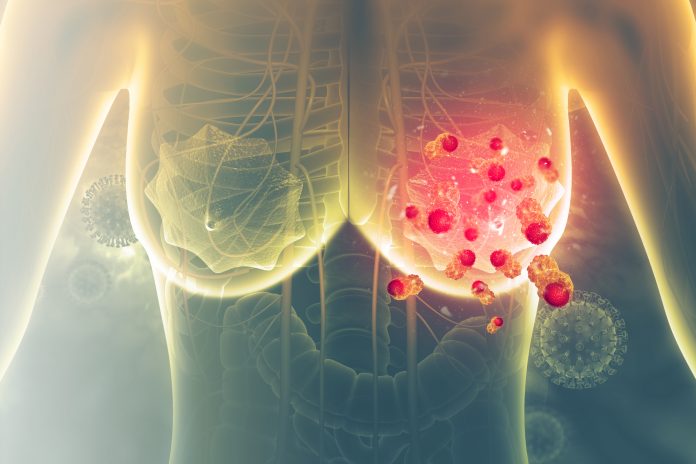
Moffit Cancer Center researchers have reported in Nature Medicine that use of an oncolytic virus treatment in combination with chemotherapy can boost response rates during neoadjuvant therapy for triple-negative breast cancer (TNBC).
The modified oncolytic herpes simplex 1 virus—talimogene laherparepvec (T-VEC)—is already approved to treat advanced melanoma. It is injected directly into the tumor and undergoes replication once inside the tumor cells. This leads to tumor cell breakdown and production of tumor derived antigens, which are then recognized by immune cells. The immune cells infiltrate the tumor and target the cancer cells for destruction. In addition, T-VEC includes coding sequences for the immune-stimulating protein GM-CSF which, when made by the virus, acts as a beacon to help recruit immune cells to the tumor.
TNBC accounts for around 15% of newly diagnosed breast cancer cases but is a therapeutic challenge because the tumors lack expression of estrogen and progesterone receptors that can be targeted with hormone therapy. They also do not express HER-2, another targetable receptor.
Lead study author Hatem Soliman, medical director of Moffitt’s Clinical Trials Office and senior member of Moffitt’s Breast Oncology Department, told Inside Precision Medicine that there are several reasons why early stage TNBC is an ideal setting to use an oncolytic virus treatment.
“TNBC has a number of alterations that predispose the tumor cells to infection with oncolytic viruses including defective interferon signaling, resistance to apoptosis, and rapid cell cycling,” he said. “There was early data suggesting that oncolytic viruses can cooperate with systemic chemotherapy, which is a standard therapy for TNBC, in eradicating tumor cells while triggering a host immune response. It also has been known that TNBC may respond better to immunotherapy relative to other breast cancer subtypes, recently culminating in the approval of pembrolizumab for the treatment of stage II-III TNBC in combination with chemotherapy.”
With these considerations in mind, Soliman and team launched a Phase II trial in 2018 to investigate the safety and efficacy of adding T-VEC to standard preoperative taxane/anthracycline chemotherapy.
“One of our goals with this research was to see if T-VEC could be an effective agent to convert more TNBC tumors from immunologically “cold” tumors into inflamed “hot” tumors in order to improve both prognosis and response to therapy,” Soliman remarked.
For the study, 37 patients with TNBC were given an intratumoral injection of T-VEC at a dose of 106 plaque-forming units (PFUs) on week 1 followed by 108 PFU on weeks 4, 6, 8, and 10 concurrently with intravenous paclitaxel 80 mg/m2 per week for 12 weeks followed by four doses intravenous doxorubicin and cyclophosphamide 60/600 mg/m2 with pegfilgrastim every two weeks.
The researchers report that 16 patients had no residual invasive disease in the breast or sampled lymph nodes after completion of neoadjuvant therapy, which corresponded to a pathologic complete response (pCR) rate of 45.9% after statistical adjustment. This compares favorably with the historic rate of around 30% typically seen with paclitaxel/doxorubicin chemotherapy alone.
An additional eight patients had minimal residual disease at the end of treatment and during a median 30 months of follow-up, four patients experienced recurrence, giving a disease-free survival rate of 89.2%. Of note, none of the recurrences occurred among women who had a complete or near complete response.
The researchers also carried out an exploratory biomarker analysis, which showed increased immune signaling within most tumors during the first six weeks of study treatment followed by a decrease of immune activation (but still above baseline) upon completion of neoadjuvant chemotherapy (NAC). Furthermore, patients who had better responses to therapy had higher levels of CD8 T cells at week 6 than patients who did not respond as well to therapy.
“This suggests that it is important to incorporate new immunotherapy agents as early as possible during NAC to exploit this early activation rather than waiting to use it as a salvage agent for residual disease after NAC or sequentially after adjuvant chemotherapy,” the authors write.
A safety analysis demonstrated that the T-VEC therapy was feasible with no significant autoimmunity noted. The safety profile did not differ significantly from that expected with standard chemotherapy, except for higher levels of low-grade fevers, chills, headaches, and injection site pain.
Soliman said that although he hopes to see oncolytic virus treatments being more widely used in future, there are still a number of challenges to be overcome in the development of these agents, including the limitations of intratumoral injection.
The difficulty of seeing sufficient single agent activity of oncolytic viruses in advanced stage disease, which is typically where new drugs are tested, may also cause some of these agents to be discarded before they can demonstrate their potential in earlier curative stages of cancer.
“We believe that injecting early stage tumors that are easily accessible like breast cancers in combination with other agents is an ideal setting to investigate the activity of oncolytic viruses,” he said.
The team is now hoping to launch additional confirmatory trials utilizing oncolytic viruses in combination with preoperative chemotherapy.













